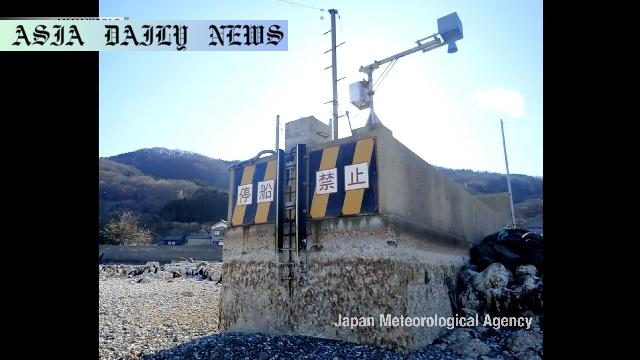Tsunami warning system updated in Japan: ‘Data not available’ label signals equipment failure, urging immediate evacuation.

Introduction: Addressing Gaps in Tsunami Observation
The Japan Meteorological Agency (JMA) has unveiled a groundbreaking update to its tsunami warning system by introducing the label ‘data not available.’ This label signifies instances where tsunami monitoring equipment is either damaged or otherwise unable to function, ensuring that the public remains informed about potential risks despite gaps in real-time data. This decision, made effective at noon on a Thursday, is part of efforts to enhance public understanding, particularly during emergencies when lives are at stake.
The need for this update stems directly from lessons learned during past natural disasters, such as last year’s earthquake in the Noto Peninsula. In this specific instance, key tsunami observation gauges became inoperable due to land uplift caused by the earthquake. Such failures highlight the need for transparent communication to foster public trust and safety in crisis scenarios.
Key Challenges and Lessons from the Past
A closer look at previous natural disasters underscores the importance of this initiative. For example, during the major earthquake in the Noto Peninsula, tsunami observation systems in Ishikawa Prefecture’s Suzu City were rendered inoperative. This left the JMA unable to provide vital information about tsunami height and timing. Similarly, observation facilities near the Tohoku region were damaged by debris swept in by massive tsunamis, leading to significant gaps in actionable data. These experiences emphasize the vulnerability of critical infrastructure during high-impact events and the urgency of overhauling communication protocols.
The new ‘data not available’ label aims to address these gaps. It acts as a contingency measure, providing clarity when conventional systems fail. By doing so, the JMA hopes to eliminate uncertainty, ensuring people interpret such situations as potentially dangerous and respond with immediate evacuation. This level of precaution is especially pivotal given the rapid onset of tsunamis after earthquakes.
The Mechanics of the New System
The JMA’s tsunami detection efforts typically involve a highly automated process, issuing major tsunami warnings, standard warnings, or advisories within three minutes of a potential threat. Further updates include observed times and heights based on data from coastal observation systems. The recent move ensures gaps in this automated system no longer leave room for ambiguity.
When ‘data not available’ is displayed, it serves as an urgent call to action for citizens. In effect, the label transforms a potential blind spot into a trigger for preventive measures. Furthermore, it reminds people not to wait for confirmation when critical information is not forthcoming. This approach reflects a broader commitment to safety over precision in the face of natural disasters.
Public Awareness and Future Implications
While the technical and operational merits of the JMA’s new system are clear, its success depends largely on public education. Citizens must understand the significance of the ‘data not available’ label and the actions it necessitates. To this end, the JMA could further enhance its outreach initiatives, leveraging media campaigns, public drills, and local government involvement to disseminate information.
Moreover, advancements in technology could reduce such gaps in the future. Deploying more robust and durable observation systems, using satellite data, and enhancing AI-based predictive models are all potential avenues for reducing equipment failures.
Nonetheless, the adoption of this system underscores Japan’s vigilance when it comes to disaster preparedness, serving as a model for other nations prone to tsunamis. By prioritizing human safety over technological perfection, the country has taken a proactive step toward minimizing casualties during future calamities.
Commentary
Prioritizing Safety Over Technological Limitations
The decision by Japan’s Meteorological Agency to introduce the ‘data not available’ label is both timely and forward-thinking. As natural disasters become more unpredictable, the margin for error grows thinner, making it all the more crucial to address gaps in warning systems. This decision puts human safety at the forefront—an approach that should resonate globally, especially in disaster-prone regions.
The inability to access real-time data during emergencies, such as witnessed in the Noto Peninsula and Tohoku region, reveals vulnerabilities inherent in overreliance on technology. While infrastructure repairs and upgrades are essential, emergencies demand instantaneous action. This new label ensures that the absence of data is not met with public inaction but instead viewed as a signal to prioritize safety. It is an intelligent workaround of a tough problem and could save lives in critical situations.
The Imperative for Public Awareness
Education plays a vital role in making this initiative successful. Without proper awareness, people might misinterpret the label as a sign of reassurance rather than a call to action. By integrating this label into public safety drills and communication channels, the JMA can ensure that the public understands its significance and acts accordingly in emergencies.
Furthermore, the introduction of this label could serve as a catalyst for reimagining disaster preparedness. It underscores a growing global need for integrating innovative yet accessible approaches to public safety.
Ultimately, the JMA’s proactive steps toward filling information gaps serves as a powerful reminder of Japan’s leadership in disaster management. While no system can be perfect, this initiative gets as close as possible by reducing the risks posed by uncertainty. It’s a pragmatic and compassionate solution—one that values lives above all else.


